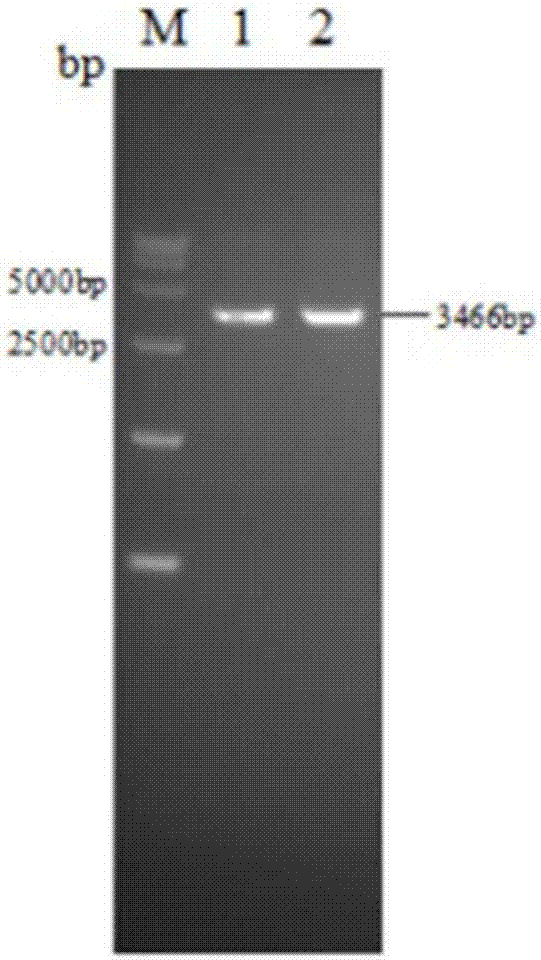High-throughput screening method and application of respiratory syncytial virus resisting drug
A high-throughput, drug technology, applied in the fields of molecular biology and biomedicine, can solve problems such as serious toxicity and teratogenic effects, and achieve the effects of simple operation, accurate reflection, and accurate virus status.
- Summary
- Abstract
- Description
- Claims
- Application Information
AI Technical Summary
Problems solved by technology
Method used
Image
Examples
Embodiment 1
[0055] Example 1 Construction of rRSV-EGFP plasmid
[0056] 1. Insert the synthetic linker ClaI-PmeI-XhoI-AsuII-XmaI-NheI-MluI-NruI into the pBR322 vector, transform it into a pBRAT vector, and use XhoI and NotI to digest the transformed vector, and obtain it at 3466bp destination strip ( figure 1 ), the vector fragment.
[0057] 2. Connect the synthetic fragment of NheⅠLMluⅠ to the vector pMD18-T to obtain the pMD18-T-L plasmid; take the synthetic fragment of A1 (PmeⅠNS1NS2NPMSHXhoⅠ), pBR322B vector, digest with PmeⅠ and XhoⅠ, and connect to obtain the pBR322B-RSV A1 plasmid; take A2 (SacISHGAsuⅡ) Synthetic fragment, pBR322B vector, SacI and AsuII digestion, ligation, to obtain pBR322B-RSV A2 plasmid.
[0058] 3. Antigenomic rRSV-EGFP plasmid construction
[0059] Take the pMD18-T-L plasmid, pBRAT vector, digest with NheI and MluI, and connect to obtain the pBRAT-L plasmid. Take the AsuIIGEGFPFM2LNheI synthetic plasmid, pBRAT-L plasmid, digest with AsuII and NheI, and conn...
Embodiment 2
[0060] Example 2 Rescue of recombinant virus
[0061] BHK T7 / 9 cells were inoculated in 6-well plates, and after 24 hours, the rRSV-EGFP plasmid and four kinds of auxiliary protein plasmids (pCDNA3.1-N, P, L, M2-1) were transfected into host cells (BHK T7 / 9) cultured at 37°C (experimental group), and set up a positive control group and a negative control group mock at the same time, wherein the positive control group was transfected with the RSV mini-replicon pBR322B-RSV-EGFP and four kinds of auxiliary protein particles (pCDNA3. 1-N, P, L, M2-1), the negative control mock was only transfected with four auxiliary protein plasmids (pCDNA3.1-N, P, L, M2-1), and blindly passed to the host cells after 96 hours of transfection HEp-2 continued to be cultured at 37°C and transfected ( image 3 ) and blind pass ( Figure 4 ) and observe the fluorescence expression under the microscope every day. According to the fluorescence of the cells, it can be judged that the experimental grou...
Embodiment 3
[0062] Example 3 Recombinant Virus Stability Identification
[0063] Fluorescent expression of rRSV-EGFP after serial passage was observed by fluorescence microscope ( Figure 5 ) and the plaque forming units (PFU / mL) of the recombinant virus after serial passage were detected by immunoenzyme method ( Image 6 ), it can be seen from the fluorescent expression of continuous passage that the rescued recombinant virus is stable, and the results of immunoenzyme detection show that the amount of rescued recombinant virus tends to be stable after 3 generations of continuous passage (P<0.05).
PUM
| Property | Measurement | Unit |
|---|---|---|
| wavelength | aaaaa | aaaaa |
| emission peak | aaaaa | aaaaa |
Abstract
Description
Claims
Application Information
 Login to View More
Login to View More - R&D
- Intellectual Property
- Life Sciences
- Materials
- Tech Scout
- Unparalleled Data Quality
- Higher Quality Content
- 60% Fewer Hallucinations
Browse by: Latest US Patents, China's latest patents, Technical Efficacy Thesaurus, Application Domain, Technology Topic, Popular Technical Reports.
© 2025 PatSnap. All rights reserved.Legal|Privacy policy|Modern Slavery Act Transparency Statement|Sitemap|About US| Contact US: help@patsnap.com



